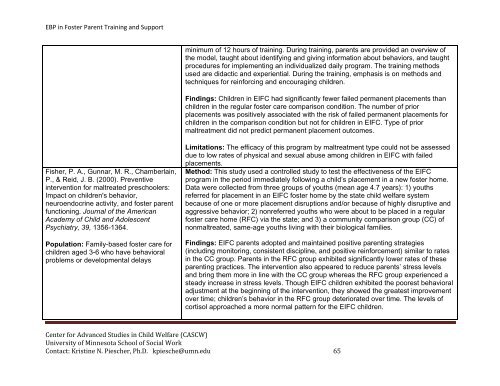Evidence-Based Practice in Foster Parent Training and Support ...
Evidence-Based Practice in Foster Parent Training and Support ...
Evidence-Based Practice in Foster Parent Training and Support ...
You also want an ePaper? Increase the reach of your titles
YUMPU automatically turns print PDFs into web optimized ePapers that Google loves.
EBP <strong>in</strong> <strong>Foster</strong> <strong>Parent</strong> Tra<strong>in</strong><strong>in</strong>g <strong>and</strong> <strong>Support</strong>m<strong>in</strong>imum of 12 hours of tra<strong>in</strong><strong>in</strong>g. Dur<strong>in</strong>g tra<strong>in</strong><strong>in</strong>g, parents are provided an overview ofthe model, taught about identify<strong>in</strong>g <strong>and</strong> giv<strong>in</strong>g <strong>in</strong>formation about behaviors, <strong>and</strong> taughtprocedures for implement<strong>in</strong>g an <strong>in</strong>dividualized daily program. The tra<strong>in</strong><strong>in</strong>g methodsused are didactic <strong>and</strong> experiential. Dur<strong>in</strong>g the tra<strong>in</strong><strong>in</strong>g, emphasis is on methods <strong>and</strong>techniques for re<strong>in</strong>forc<strong>in</strong>g <strong>and</strong> encourag<strong>in</strong>g children.F<strong>in</strong>d<strong>in</strong>gs: Children <strong>in</strong> EIFC had significantly fewer failed permanent placements thanchildren <strong>in</strong> the regular foster care comparison condition. The number of priorplacements was positively associated with the risk of failed permanent placements forchildren <strong>in</strong> the comparison condition but not for children <strong>in</strong> EIFC. Type of priormaltreatment did not predict permanent placement outcomes.Fisher, P. A., Gunnar, M. R., Chamberla<strong>in</strong>,P., & Reid, J. B. (2000). Preventive<strong>in</strong>tervention for maltreated preschoolers:Impact on children's behavior,neuroendocr<strong>in</strong>e activity, <strong>and</strong> foster parentfunction<strong>in</strong>g. Journal of the AmericanAcademy of Child <strong>and</strong> AdolescentPsychiatry, 39, 1356-1364.Population: Family-based foster care forchildren aged 3-6 who have behavioralproblems or developmental delaysLimitations: The efficacy of this program by maltreatment type could not be assesseddue to low rates of physical <strong>and</strong> sexual abuse among children <strong>in</strong> EIFC with failedplacements.Method: This study used a controlled study to test the effectiveness of the EIFCprogram <strong>in</strong> the period immediately follow<strong>in</strong>g a child’s placement <strong>in</strong> a new foster home.Data were collected from three groups of youths (mean age 4.7 years): 1) youthsreferred for placement <strong>in</strong> an EIFC foster home by the state child welfare systembecause of one or more placement disruptions <strong>and</strong>/or because of highly disruptive <strong>and</strong>aggressive behavior; 2) nonreferred youths who were about to be placed <strong>in</strong> a regularfoster care home (RFC) via the state; <strong>and</strong> 3) a community comparison group (CC) ofnonmaltreated, same-age youths liv<strong>in</strong>g with their biological families.F<strong>in</strong>d<strong>in</strong>gs: EIFC parents adopted <strong>and</strong> ma<strong>in</strong>ta<strong>in</strong>ed positive parent<strong>in</strong>g strategies(<strong>in</strong>clud<strong>in</strong>g monitor<strong>in</strong>g, consistent discipl<strong>in</strong>e, <strong>and</strong> positive re<strong>in</strong>forcement) similar to rates<strong>in</strong> the CC group. <strong>Parent</strong>s <strong>in</strong> the RFC group exhibited significantly lower rates of theseparent<strong>in</strong>g practices. The <strong>in</strong>tervention also appeared to reduce parents’ stress levels<strong>and</strong> br<strong>in</strong>g them more <strong>in</strong> l<strong>in</strong>e with the CC group whereas the RFC group experienced asteady <strong>in</strong>crease <strong>in</strong> stress levels. Though EIFC children exhibited the poorest behavioraladjustment at the beg<strong>in</strong>n<strong>in</strong>g of the <strong>in</strong>tervention, they showed the greatest improvementover time; children’s behavior <strong>in</strong> the RFC group deteriorated over time. The levels ofcortisol approached a more normal pattern for the EIFC children.Center for Advanced Studies <strong>in</strong> Child Welfare (CASCW)University of M<strong>in</strong>nesota School of Social WorkContact: Krist<strong>in</strong>e N. Piescher, Ph.D. kpiesche@umn.edu 65
















